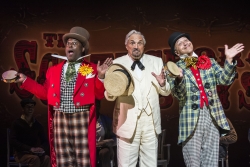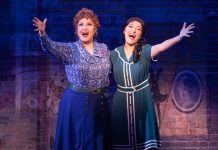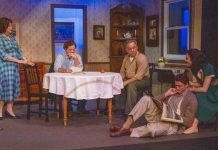A weighty story performed brilliantly
The Scottsboro Boys, playing at the Ahmanson Theatre, is Kander and Ebb’s last collaboration together – Kander having to finish the lyrics after Fred Ebb’s death in 2004.
With David Thompson writing the book and Susan Stroman directing it ran for only a limited time in 2010 on Broadway, yet still managed to garner 12 Tony award nominations.
However, being up against The Book of Mormon, amongst others, it failed to win a single award. The Scottsboro Boysis the story of the trials of the Scottsboro Nine.
In 1931, nine black men were pulled off a train in Alabama and falsely accused of raping two white women. They were all found guilty.
Because of the speed in which the trial was held and the inherent frame-up of the boys, the youngest being 13 years old, the NAACP and the International Labor Defense stepped in to raise funds and represent the men. Despite one of the women changing her testimony they were still found guilty in subsequent appeals.
The Scottsboro Boys tackles a weighty story, and does it brilliantly by using the structure of a minstrel show to tell the story.
Minstrel shows reached the height of their popularity in the 1840s and featured the Interlocutor, or host, and such stock characters as Mr. Bones and Mr. Tambo. They featured actors in black face – before the Civil War these were white actors, after the war these were often black actors – and portrayed African-American’s as dim-witted, happy-go-lucky, lazy and musical.
The productions were full of lively dancing, singing, shadow-puppetry and over the top vaudevillian style acting. Minstrel shows were the first singularly American theatrical form and for many in that time the only glimpse that white people had of African-American culture.
This structure/convention fits the farcical nature of the trials held in Alabama to an eerie precision. For many Southerners in that time period the trial was simply a formality, a show that had to be carried out for appearances.
Those boys were guilty simply because of the color of their skin. The Scottsboro Boys puts on one hell of a minstrel show and in doing so, paints an uncomfortable commentary on our country’s treatment of African-American’s.
There are bright lights, lively dancing, great interactions between Mr. Bones, Mr. Tambo and the Interlocutor and oh yeah, moments thrown in, like in the beginning, where one of the boys steps forward and asks, “This time can we tell the truth?”
At the beginning these moments are brushed away and ignored, but by the end the Scottsboro boys are tired of putting on an act that all is well and good, and they turn against the Interlocutor.
It was during the number “Electric Chair” that this message struck home. Part way through this upbeat number with spectacular dancing did a realization crawl up my spine that this white woman was enjoying a song about black men being fried in an electric chair.
I was so caught up in the spectacle that I had lost sight of the reality of the number. The light-hearted, mocking treatment of the subject had turned me complacent and that complacency and entertainment mirrored the attitudes of 1930s Alabama in a hugely unsettling way.
Later in the song “Southern Days” the boys start out singing, at the insistence of the Interlocutor, all about the peace and beauty of living in the South, but by the end of the number have changed the lyrics to represent the Southern experience for a black man, making the Interlocutor highly uncomfortable.
The ensemble is stunning with Joshua Henry as Haywood Patterson the leader of the Scottsboro boys.
The two women that accuse the men of rape, played by two of the Scottsboro boys Christian Dante White and Gilbert L. Bailey II, provide much needed levity and they do a fantastic job of embodying the minstrel show archetype of the wench/jezebel – who historically would have been played by men.
There is only one woman in the cast, and until the end she is an observer, concerned with all that is happening but never interceding. Her presence is at times puzzling, but beautifully explained in the end.
Toni-Leslie James does a superb job of providing costumes that are both true to the minstrel origins, but versatile enough to cover all of the parts played by the characters.
The set by Beowulf Boritt consists of an ingenious use of metal chairs, tambourines and planks that rearrange to create the different locales, relying on the lighting design of Ken Billington to finish the look utilizing both lights and shadows on the cyclorama.
At times the larger than life shadows on the cyc tell as much of a story as the men that are throwing the shadows.
The metatheatrical commentary that takes place in this production is introduced so subtly, it will slap you in the face before you even realize that it’s there. It is spectacularly done, both in script and in performance.
“Scottsboro Boys”
Center Theatre Group
Through June 30
Tickets: www.centertheatregroup.org or 213-972-4400
Kat Michels is a two time regional Emmy award-winning writer with an AAS in video production and a BFA in theatre. www.katmichels.com













